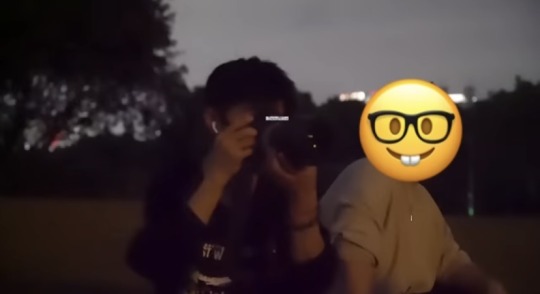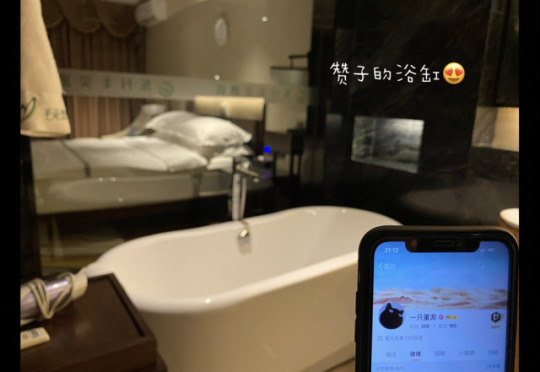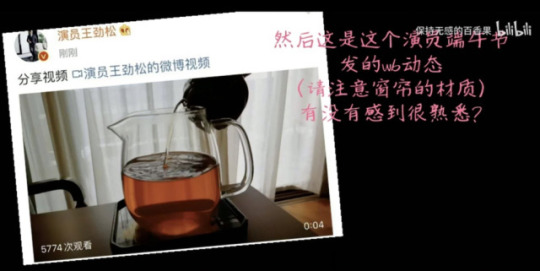#so many yibis!!!!!!!!
Explore tagged Tumblr posts
Text
wang yibo - announced as chief spokesperson of YAYA
From the stage to the screen to the track, he has experienced multiple life roles, and he has gone all out for his love; from the first manufacturer of down jackets in China to the global leader in down jacket sales, it has used quality to create classics. Welcome @UNIQ-王一博 to become the chief spokesperson of YAYA brand.
#wang yibo#it’s v interesting to me how he’s picking up homegrown or national brands#that’s actually smart considering the politics of the world#hahahahahahha that got v deep#but anyway#CONGRATULATIONS WYB!!!!!#so many yibis!!!!!!!!
34 notes
·
View notes
Text
I'm gonna watch Ace Troops for the plot
The plot:

34 notes
·
View notes
Note
9 and 18
send me a number
Thanks for the ask!!
9. Most disliked characters? Why? To answer this question was the reason I was born. Prepare for some mega. fucking. salt. In no particular order aside from the first two. Also regular disclaimers, don’t come at me with a pitchfork if your fave is on here. These are just my opinions.
1. Rika, my most hated fictional character of all time and will remain so until the day I die. Her entire character consists of “boo fucking hoo why won’t anyone love me even though I’m abusive and have no intentions of changing my ways :(” and also shallow sun metaphors. She’s just garbage in its finest form.
2. Ruruka from dr3. My hatred for Ruruka is close and personal and I nearly hate her as much as Rika but not as much. Fuck her and her “uwuwu Seiko won’t eat my candy because she is fucking allergic so I’m gonna treat her like shit uwuwu!” and fuck everyone who defends her blatantly manipulative bullshit. It sickens me to watch her fans excuse her behavior because abusive friendships don’t exist, clearly!
3. Hitomi from Madoka Magica. I’ve watched that anime when I was 12, and I hated her. It’s been what? 6 years? And I still hate her. I’m sorry but she is an awful friend and she can take her manipulative bullshit and exit the stage on the left thank you very much.
4. Yuki from Mirai Nikki. Akise did not die for him to have sex with Yuno and not give a shit over the fact that all his friends are dead because of him. Can you tell the trend. “Bad friend” characters disgust me l o l.
5. Ciel from Kuroshitsuji. THAT FUCKING CIRCUS ARC.
6. Saionji from sdr2. Literally you could cut out half of her dialogue lines and nothing would change. Even her death had no impact.
7. Mutsuki from Tokyo Ghoul. “How not to write a yandere 101″.
8. V. I have already expressed my disdain for him here here and here so I don’t think I needa elaborate. He could have been a great character full of heart ache and development but honestly his character just didn’t deliver. Ray was literally the only enjoyable thing about his entire route.
9. Special mention: Kamoshido (persona 5), Kando and Hideyoshi (nightshade), Mado (Tokyo ghoul) and Jiyeon (Dandelion). I don’t have any special reasons for hating these guys, they’re just fucking assholes.
18. Does not shipping something ‘popular’ mean you’re in denial and/or biased? I mean everyone has bias when it comes to ships. The denial can really only come into play if the ship is canon but honestly, how many canon ships are actually popular. Not many I bet LMAO. Yibi from School 2015 is canon and to this day I’m still fucking salty and I’m sure many other people are too. When that ship became canon, people were furious and I empathize 100% because I was furious too.
1 note
·
View note
Text
What It's Like When A Guinea Worm Living Inside Your Body Suddenly Burrows Out
This article is part of HuffPost’s Project Zero campaign, a yearlong series on neglected tropical diseases and efforts to fight them.
JUBA, South Sudan ― It took days for Maker Achuil and others to slowly pull the arm-length, spaghetti-like worm out of his thigh. After a year with the white parasite inside him, Achuil screamed in pain as the grown Guinea worm emerged.
A former soldier in South Sudan, which fought for decades before gaining its independence from Sudan in 2011, Achuil still shudders at the memory of the agony he felt as the worm was gradually wound around a stick.
“It was like putting a cigarette out on your leg ― for days,” said Achuil, rolling up his trouser to show the scars from the burning fluids the worm excreted as it burrowed out to breed. “It made you exhausted, but you were in too much pain to sleep. All you wanted to do was swim in the lake to cool the pain.”
The worms, which resemble stretched chewing gum, lay their microscopic young in stagnant water. People drink the water and ingest the worms, which grow and mate inside the host for about a year. The male dies and the female starts to dig its way out through the human host’s flesh. When that person submerges the affected area in water, say, to bathe or to dull the burning pain, the worm spews out its young.
Guinea worm disease was once common across Africa and Asia, with an estimated 3.5 million cases in 1986. But in the mid-1980s, the global health community launched a campaign to eliminate the disease, and today it’s limited to pockets of Africa.
Last year only a handful of cases were reported in three countries ― Chad, Ethiopia and South Sudan ― and health experts are confident they can finally slay the worm for good. The fight in South Sudan, once a stronghold of the crippling parasite, could be won soon, despite a brutal civil war that has engulfed that country since 2013.
“We are on the very edge of breaking transmission in South Sudan,” said Makoy Samuel Yibi, who heads the worm eradication program at the nation’s ministry of health. “We are in sight of the end.”
Scientifically, the worms that infect humans are known as Dracunculus medinensis. Historians believe it has been around since ancient times and is mentioned in the Bible’s Old Testament as the “fiery serpent.”
If the Guinea worm is made extinct, it would represent the very first parasitic disease ever to be eradicated, and only the second human disease to be wiped out (after smallpox).
type=type=RelatedArticlesblockTitle=Related Stories + articlesList=58fe142be4b018a9ce5d277d,58f8f186e4b00fa7de1227e6,58d2ac02e4b0f838c62e9e0d
Yibi, a soft-spoken man, has dedicated his life to ending this parasitic disease. The health official remembers how in his home village of a few hundred people, at least 50 individuals every year were so debilitated by the pain of the worms that they could not farm their fields.
“It tormented people, deformed them, but they did not talk about it,” he said.
Now across South Sudan, the local efforts led by Yibi have driven down the number of cases by over 90 percent in the past three years. Just six cases were reported in 2016, compared to 70 cases in 2014.
Ethiopia saw only three cases last year, and Chad was hit with just 16.
“The progress we have seen in restricting Guinea worm disease to these few cases in only three countries is a testament to the dedication of people in endemic areas to caring for their health and that of their communities,” said Dr. Dean Sienko, vice president of health programs at the Carter Center.
The Atlanta-based center ― which was founded by former President Jimmy Carter and his wife, Rosalynn ― has helped coordinate the decades-long global campaign to finally wipe the disease from the world map, including brokering a legendary three-month ceasefire in 1995 in what is now South Sudan to make sure the Guinea worm eradication program would survive.
“People have lived with this for generations,” Yibi said. “We are hoping that in 2017, we will probably get to zero.”
While there is no direct medication for the disease, the worm’s breeding cycle can be broken by ensuring that infected people do not enter bodies of water ― especially those used for drinking water ― while the worm is working its way out of the skin.
The cycle can also be broken by giving people access to cleaner water sources or by cleaning the water before they drink it. In South Sudan, people have been encouraged to use water filters to avoid swallowing the worm’s eggs.
It has been a long, hard process, said Yibi, but “now when I go back to a village where Guinea worm was once common and ask if there are cases, the people shout, ‘No! We don’t want to even hear its name. That is dead and gone to us.’”
Ironically, even as so many other species face extinction due to humankind’s excesses, this human-reliant species is finding new ways to survive. In Mali, which last year reported no Guinea worm cases for the first time in 25 years, health workers have found dogs infected with the parasite. The worms have also been boring their way into dogs in Chad.
Still, health experts remain optimistic.
Dr. Donald Hopkins is the architect of the Guinea worm eradication campaign that started in the 1980s. He serves as the Carter Center’s special adviser on Guinea worm and also worked on the campaign to end smallpox. Those infections in animals are just “another puzzle to be solved,” he said.
“We’ve navigated plenty of challenges, including wars, over the 30 years we’ve been working to eradicate Guinea worm,” Hopkins said.
The worm’s centuries of agonizing pain may soon be consigned to history.
The Carter Center is the recipient of grants from the Bill & Melinda Gates Foundation, which also supports this HuffPost series. All content is editorially independent, with no influence or input from the foundation.
If you’d like to contribute a post to the series, send an email to [email protected]. And follow the conversation on social media by using the hashtag #ProjectZero.
-- This feed and its contents are the property of The Huffington Post, and use is subject to our terms. It may be used for personal consumption, but may not be distributed on a website.
from http://ift.tt/2qn1n0I from Blogger http://ift.tt/2qroncP
0 notes
Text
What It's Like When A Guinea Worm Living Inside Your Body Suddenly Burrows Out
This article is part of HuffPost’s Project Zero campaign, a yearlong series on neglected tropical diseases and efforts to fight them.
JUBA, South Sudan ― It took days for Maker Achuil and others to slowly pull the arm-length, spaghetti-like worm out of his thigh. After a year with the white parasite inside him, Achuil screamed in pain as the grown Guinea worm emerged.
A former soldier in South Sudan, which fought for decades before gaining its independence from Sudan in 2011, Achuil still shudders at the memory of the agony he felt as the worm was gradually wound around a stick.
“It was like putting a cigarette out on your leg ― for days,” said Achuil, rolling up his trouser to show the scars from the burning fluids the worm excreted as it burrowed out to breed. “It made you exhausted, but you were in too much pain to sleep. All you wanted to do was swim in the lake to cool the pain.”
The worms, which resemble stretched chewing gum, lay their microscopic young in stagnant water. People drink the water and ingest the worms, which grow and mate inside the host for about a year. The male dies and the female starts to dig its way out through the human host’s flesh. When that person submerges the affected area in water, say, to bathe or to dull the burning pain, the worm spews out its young.
Guinea worm disease was once common across Africa and Asia, with an estimated 3.5 million cases in 1986. But in the mid-1980s, the global health community launched a campaign to eliminate the disease, and today it’s limited to pockets of Africa.
Last year only a handful of cases were reported in three countries ― Chad, Ethiopia and South Sudan ― and health experts are confident they can finally slay the worm for good. The fight in South Sudan, once a stronghold of the crippling parasite, could be won soon, despite a brutal civil war that has engulfed that country since 2013.
“We are on the very edge of breaking transmission in South Sudan,” said Makoy Samuel Yibi, who heads the worm eradication program at the nation’s ministry of health. “We are in sight of the end.”
Scientifically, the worms that infect humans are known as Dracunculus medinensis. Historians believe it has been around since ancient times and is mentioned in the Bible’s Old Testament as the “fiery serpent.”
If the Guinea worm is made extinct, it would represent the very first parasitic disease ever to be eradicated, and only the second human disease to be wiped out (after smallpox).
type=type=RelatedArticlesblockTitle=Related Stories + articlesList=58fe142be4b018a9ce5d277d,58f8f186e4b00fa7de1227e6,58d2ac02e4b0f838c62e9e0d
Yibi, a soft-spoken man, has dedicated his life to ending this parasitic disease. The health official remembers how in his home village of a few hundred people, at least 50 individuals every year were so debilitated by the pain of the worms that they could not farm their fields.
“It tormented people, deformed them, but they did not talk about it,” he said.
Now across South Sudan, the local efforts led by Yibi have driven down the number of cases by over 90 percent in the past three years. Just six cases were reported in 2016, compared to 70 cases in 2014.
Ethiopia saw only three cases last year, and Chad was hit with just 16.
“The progress we have seen in restricting Guinea worm disease to these few cases in only three countries is a testament to the dedication of people in endemic areas to caring for their health and that of their communities,” said Dr. Dean Sienko, vice president of health programs at the Carter Center.
The Atlanta-based center ― which was founded by former President Jimmy Carter and his wife, Rosalynn ― has helped coordinate the decades-long global campaign to finally wipe the disease from the world map, including brokering a legendary three-month ceasefire in 1995 in what is now South Sudan to make sure the Guinea worm eradication program would survive.
“People have lived with this for generations,” Yibi said. “We are hoping that in 2017, we will probably get to zero.”
While there is no direct medication for the disease, the worm’s breeding cycle can be broken by ensuring that infected people do not enter bodies of water ― especially those used for drinking water ― while the worm is working its way out of the skin.
The cycle can also be broken by giving people access to cleaner water sources or by cleaning the water before they drink it. In South Sudan, people have been encouraged to use water filters to avoid swallowing the worm’s eggs.
It has been a long, hard process, said Yibi, but “now when I go back to a village where Guinea worm was once common and ask if there are cases, the people shout, ‘No! We don’t want to even hear its name. That is dead and gone to us.’”
Ironically, even as so many other species face extinction due to humankind’s excesses, this human-reliant species is finding new ways to survive. In Mali, which last year reported no Guinea worm cases for the first time in 25 years, health workers have found dogs infected with the parasite. The worms have also been boring their way into dogs in Chad.
Still, health experts remain optimistic.
Dr. Donald Hopkins is the architect of the Guinea worm eradication campaign that started in the 1980s. He serves as the Carter Center’s special adviser on Guinea worm and also worked on the campaign to end smallpox. Those infections in animals are just “another puzzle to be solved,” he said.
“We’ve navigated plenty of challenges, including wars, over the 30 years we’ve been working to eradicate Guinea worm,” Hopkins said.
The worm’s centuries of agonizing pain may soon be consigned to history.
The Carter Center is the recipient of grants from the Bill & Melinda Gates Foundation, which also supports this HuffPost series. All content is editorially independent, with no influence or input from the foundation.
If you’d like to contribute a post to the series, send an email to [email protected]. And follow the conversation on social media by using the hashtag #ProjectZero.
-- This feed and its contents are the property of The Huffington Post, and use is subject to our terms. It may be used for personal consumption, but may not be distributed on a website.
What It's Like When A Guinea Worm Living Inside Your Body Suddenly Burrows Out published first on http://ift.tt/2lnpciY
0 notes
Text
What It's Like When A Guinea Worm Living Inside Your Body Suddenly Burrows Out
This article is part of HuffPost’s Project Zero campaign, a yearlong series on neglected tropical diseases and efforts to fight them.
JUBA, South Sudan ― It took days for Maker Achuil and others to slowly pull the arm-length, spaghetti-like worm out of his thigh. After a year with the white parasite inside him, Achuil screamed in pain as the grown Guinea worm emerged.
A former soldier in South Sudan, which fought for decades before gaining its independence from Sudan in 2011, Achuil still shudders at the memory of the agony he felt as the worm was gradually wound around a stick.
“It was like putting a cigarette out on your leg ― for days,” said Achuil, rolling up his trouser to show the scars from the burning fluids the worm excreted as it burrowed out to breed. “It made you exhausted, but you were in too much pain to sleep. All you wanted to do was swim in the lake to cool the pain.”
The worms, which resemble stretched chewing gum, lay their microscopic young in stagnant water. People drink the water and ingest the worms, which grow and mate inside the host for about a year. The male dies and the female starts to dig its way out through the human host’s flesh. When that person submerges the affected area in water, say, to bathe or to dull the burning pain, the worm spews out its young.
Guinea worm disease was once common across Africa and Asia, with an estimated 3.5 million cases in 1986. But in the mid-1980s, the global health community launched a campaign to eliminate the disease, and today it’s limited to pockets of Africa.
Last year only a handful of cases were reported in three countries ― Chad, Ethiopia and South Sudan ― and health experts are confident they can finally slay the worm for good. The fight in South Sudan, once a stronghold of the crippling parasite, could be won soon, despite a brutal civil war that has engulfed that country since 2013.
“We are on the very edge of breaking transmission in South Sudan,” said Makoy Samuel Yibi, who heads the worm eradication program at the nation’s ministry of health. “We are in sight of the end.”
Scientifically, the worms that infect humans are known as Dracunculus medinensis. Historians believe it has been around since ancient times and is mentioned in the Bible’s Old Testament as the “fiery serpent.”
If the Guinea worm is made extinct, it would represent the very first parasitic disease ever to be eradicated, and only the second human disease to be wiped out (after smallpox).
type=type=RelatedArticlesblockTitle=Related Stories + articlesList=58fe142be4b018a9ce5d277d,58f8f186e4b00fa7de1227e6,58d2ac02e4b0f838c62e9e0d
Yibi, a soft-spoken man, has dedicated his life to ending this parasitic disease. The health official remembers how in his home village of a few hundred people, at least 50 individuals every year were so debilitated by the pain of the worms that they could not farm their fields.
“It tormented people, deformed them, but they did not talk about it,” he said.
Now across South Sudan, the local efforts led by Yibi have driven down the number of cases by over 90 percent in the past three years. Just six cases were reported in 2016, compared to 70 cases in 2014.
Ethiopia saw only three cases last year, and Chad was hit with just 16.
“The progress we have seen in restricting Guinea worm disease to these few cases in only three countries is a testament to the dedication of people in endemic areas to caring for their health and that of their communities,” said Dr. Dean Sienko, vice president of health programs at the Carter Center.
The Atlanta-based center ― which was founded by former President Jimmy Carter and his wife, Rosalynn ― has helped coordinate the decades-long global campaign to finally wipe the disease from the world map, including brokering a legendary three-month ceasefire in 1995 in what is now South Sudan to make sure the Guinea worm eradication program would survive.
“People have lived with this for generations,” Yibi said. “We are hoping that in 2017, we will probably get to zero.”
While there is no direct medication for the disease, the worm’s breeding cycle can be broken by ensuring that infected people do not enter bodies of water ― especially those used for drinking water ― while the worm is working its way out of the skin.
The cycle can also be broken by giving people access to cleaner water sources or by cleaning the water before they drink it. In South Sudan, people have been encouraged to use water filters to avoid swallowing the worm’s eggs.
It has been a long, hard process, said Yibi, but “now when I go back to a village where Guinea worm was once common and ask if there are cases, the people shout, ‘No! We don’t want to even hear its name. That is dead and gone to us.’”
Ironically, even as so many other species face extinction due to humankind’s excesses, this human-reliant species is finding new ways to survive. In Mali, which last year reported no Guinea worm cases for the first time in 25 years, health workers have found dogs infected with the parasite. The worms have also been boring their way into dogs in Chad.
Still, health experts remain optimistic.
Dr. Donald Hopkins is the architect of the Guinea worm eradication campaign that started in the 1980s. He serves as the Carter Center’s special adviser on Guinea worm and also worked on the campaign to end smallpox. Those infections in animals are just “another puzzle to be solved,” he said.
“We’ve navigated plenty of challenges, including wars, over the 30 years we’ve been working to eradicate Guinea worm,” Hopkins said.
The worm’s centuries of agonizing pain may soon be consigned to history.
The Carter Center is the recipient of grants from the Bill & Melinda Gates Foundation, which also supports this HuffPost series. All content is editorially independent, with no influence or input from the foundation.
If you’d like to contribute a post to the series, send an email to [email protected]. And follow the conversation on social media by using the hashtag #ProjectZero.
-- This feed and its contents are the property of The Huffington Post, and use is subject to our terms. It may be used for personal consumption, but may not be distributed on a website.
from Healthy Living - The Huffington Post http://bit.ly/2pFDTVm
0 notes
Text
What It's Like When A Guinea Worm Living Inside Your Body Suddenly Burrows Out
This article is part of HuffPost’s Project Zero campaign, a yearlong series on neglected tropical diseases and efforts to fight them.
JUBA, South Sudan ― It took days for Maker Achuil and others to slowly pull the arm-length, spaghetti-like worm out of his thigh. After a year with the white parasite inside him, Achuil screamed in pain as the grown Guinea worm emerged.
A former soldier in South Sudan, which fought for decades before gaining its independence from Sudan in 2011, Achuil still shudders at the memory of the agony he felt as the worm was gradually wound around a stick.
“It was like putting a cigarette out on your leg ― for days,” said Achuil, rolling up his trouser to show the scars from the burning fluids the worm excreted as it burrowed out to breed. “It made you exhausted, but you were in too much pain to sleep. All you wanted to do was swim in the lake to cool the pain.”
The worms, which resemble stretched chewing gum, lay their microscopic young in stagnant water. People drink the water and ingest the worms, which grow and mate inside the host for about a year. The male dies and the female starts to dig its way out through the human host’s flesh. When that person submerges the affected area in water, say, to bathe or to dull the burning pain, the worm spews out its young.
Guinea worm disease was once common across Africa and Asia, with an estimated 3.5 million cases in 1986. But in the mid-1980s, the global health community launched a campaign to eliminate the disease, and today it’s limited to pockets of Africa.
Last year only a handful of cases were reported in three countries ― Chad, Ethiopia and South Sudan ― and health experts are confident they can finally slay the worm for good. The fight in South Sudan, once a stronghold of the crippling parasite, could be won soon, despite a brutal civil war that has engulfed that country since 2013.
“We are on the very edge of breaking transmission in South Sudan,” said Makoy Samuel Yibi, who heads the worm eradication program at the nation’s ministry of health. “We are in sight of the end.”
Scientifically, the worms that infect humans are known as Dracunculus medinensis. Historians believe it has been around since ancient times and is mentioned in the Bible’s Old Testament as the “fiery serpent.”
If the Guinea worm is made extinct, it would represent the very first parasitic disease ever to be eradicated, and only the second human disease to be wiped out (after smallpox).
type=type=RelatedArticlesblockTitle=Related Stories + articlesList=58fe142be4b018a9ce5d277d,58f8f186e4b00fa7de1227e6,58d2ac02e4b0f838c62e9e0d
Yibi, a soft-spoken man, has dedicated his life to ending this parasitic disease. The health official remembers how in his home village of a few hundred people, at least 50 individuals every year were so debilitated by the pain of the worms that they could not farm their fields.
“It tormented people, deformed them, but they did not talk about it,” he said.
Now across South Sudan, the local efforts led by Yibi have driven down the number of cases by over 90 percent in the past three years. Just six cases were reported in 2016, compared to 70 cases in 2014.
Ethiopia saw only three cases last year, and Chad was hit with just 16.
“The progress we have seen in restricting Guinea worm disease to these few cases in only three countries is a testament to the dedication of people in endemic areas to caring for their health and that of their communities,” said Dr. Dean Sienko, vice president of health programs at the Carter Center.
The Atlanta-based center ― which was founded by former President Jimmy Carter and his wife, Rosalynn ― has helped coordinate the decades-long global campaign to finally wipe the disease from the world map, including brokering a legendary three-month ceasefire in 1995 in what is now South Sudan to make sure the Guinea worm eradication program would survive.
“People have lived with this for generations,” Yibi said. “We are hoping that in 2017, we will probably get to zero.”
While there is no direct medication for the disease, the worm’s breeding cycle can be broken by ensuring that infected people do not enter bodies of water ― especially those used for drinking water ― while the worm is working its way out of the skin.
The cycle can also be broken by giving people access to cleaner water sources or by cleaning the water before they drink it. In South Sudan, people have been encouraged to use water filters to avoid swallowing the worm’s eggs.
It has been a long, hard process, said Yibi, but “now when I go back to a village where Guinea worm was once common and ask if there are cases, the people shout, ‘No! We don’t want to even hear its name. That is dead and gone to us.’”
Ironically, even as so many other species face extinction due to humankind’s excesses, this human-reliant species is finding new ways to survive. In Mali, which last year reported no Guinea worm cases for the first time in 25 years, health workers have found dogs infected with the parasite. The worms have also been boring their way into dogs in Chad.
Still, health experts remain optimistic.
Dr. Donald Hopkins is the architect of the Guinea worm eradication campaign that started in the 1980s. He serves as the Carter Center’s special adviser on Guinea worm and also worked on the campaign to end smallpox. Those infections in animals are just “another puzzle to be solved,” he said.
“We’ve navigated plenty of challenges, including wars, over the 30 years we’ve been working to eradicate Guinea worm,” Hopkins said.
The worm’s centuries of agonizing pain may soon be consigned to history.
The Carter Center is the recipient of grants from the Bill & Melinda Gates Foundation, which also supports this HuffPost series. All content is editorially independent, with no influence or input from the foundation.
If you’d like to contribute a post to the series, send an email to [email protected]. And follow the conversation on social media by using the hashtag #ProjectZero.
-- This feed and its contents are the property of The Huffington Post, and use is subject to our terms. It may be used for personal consumption, but may not be distributed on a website.
from DIYS http://ift.tt/2qn0Rzm
0 notes
Text
What It's Like When A Guinea Worm Living Inside Your Body Suddenly Burrows Out
This article is part of HuffPost’s Project Zero campaign, a yearlong series on neglected tropical diseases and efforts to fight them.
JUBA, South Sudan ― It took days for Maker Achuil and others to slowly pull the arm-length, spaghetti-like worm out of his thigh. After a year with the white parasite inside him, Achuil screamed in pain as the grown Guinea worm emerged.
A former soldier in South Sudan, which fought for decades before gaining its independence from Sudan in 2011, Achuil still shudders at the memory of the agony he felt as the worm was gradually wound around a stick.
“It was like putting a cigarette out on your leg ― for days,” said Achuil, rolling up his trouser to show the scars from the burning fluids the worm excreted as it burrowed out to breed. “It made you exhausted, but you were in too much pain to sleep. All you wanted to do was swim in the lake to cool the pain.”
The worms, which resemble stretched chewing gum, lay their microscopic young in stagnant water. People drink the water and ingest the worms, which grow and mate inside the host for about a year. The male dies and the female starts to dig its way out through the human host’s flesh. When that person submerges the affected area in water, say, to bathe or to dull the burning pain, the worm spews out its young.
Guinea worm disease was once common across Africa and Asia, with an estimated 3.5 million cases in 1986. But in the mid-1980s, the global health community launched a campaign to eliminate the disease, and today it’s limited to pockets of Africa.
Last year only a handful of cases were reported in three countries ― Chad, Ethiopia and South Sudan ― and health experts are confident they can finally slay the worm for good. The fight in South Sudan, once a stronghold of the crippling parasite, could be won soon, despite a brutal civil war that has engulfed that country since 2013.
“We are on the very edge of breaking transmission in South Sudan,” said Makoy Samuel Yibi, who heads the worm eradication program at the nation’s ministry of health. “We are in sight of the end.”
Scientifically, the worms that infect humans are known as Dracunculus medinensis. Historians believe it has been around since ancient times and is mentioned in the Bible’s Old Testament as the “fiery serpent.”
If the Guinea worm is made extinct, it would represent the very first parasitic disease ever to be eradicated, and only the second human disease to be wiped out (after smallpox).
type=type=RelatedArticlesblockTitle=Related Stories + articlesList=58fe142be4b018a9ce5d277d,58f8f186e4b00fa7de1227e6,58d2ac02e4b0f838c62e9e0d
Yibi, a soft-spoken man, has dedicated his life to ending this parasitic disease. The health official remembers how in his home village of a few hundred people, at least 50 individuals every year were so debilitated by the pain of the worms that they could not farm their fields.
“It tormented people, deformed them, but they did not talk about it,” he said.
Now across South Sudan, the local efforts led by Yibi have driven down the number of cases by over 90 percent in the past three years. Just six cases were reported in 2016, compared to 70 cases in 2014.
Ethiopia saw only three cases last year, and Chad was hit with just 16.
“The progress we have seen in restricting Guinea worm disease to these few cases in only three countries is a testament to the dedication of people in endemic areas to caring for their health and that of their communities,” said Dr. Dean Sienko, vice president of health programs at the Carter Center.
The Atlanta-based center ― which was founded by former President Jimmy Carter and his wife, Rosalynn ― has helped coordinate the decades-long global campaign to finally wipe the disease from the world map, including brokering a legendary three-month ceasefire in 1995 in what is now South Sudan to make sure the Guinea worm eradication program would survive.
“People have lived with this for generations,” Yibi said. “We are hoping that in 2017, we will probably get to zero.”
While there is no direct medication for the disease, the worm’s breeding cycle can be broken by ensuring that infected people do not enter bodies of water ― especially those used for drinking water ― while the worm is working its way out of the skin.
The cycle can also be broken by giving people access to cleaner water sources or by cleaning the water before they drink it. In South Sudan, people have been encouraged to use water filters to avoid swallowing the worm’s eggs.
It has been a long, hard process, said Yibi, but “now when I go back to a village where Guinea worm was once common and ask if there are cases, the people shout, ‘No! We don’t want to even hear its name. That is dead and gone to us.’”
Ironically, even as so many other species face extinction due to humankind’s excesses, this human-reliant species is finding new ways to survive. In Mali, which last year reported no Guinea worm cases for the first time in 25 years, health workers have found dogs infected with the parasite. The worms have also been boring their way into dogs in Chad.
Still, health experts remain optimistic.
Dr. Donald Hopkins is the architect of the Guinea worm eradication campaign that started in the 1980s. He serves as the Carter Center’s special adviser on Guinea worm and also worked on the campaign to end smallpox. Those infections in animals are just “another puzzle to be solved,” he said.
“We’ve navigated plenty of challenges, including wars, over the 30 years we’ve been working to eradicate Guinea worm,” Hopkins said.
The worm’s centuries of agonizing pain may soon be consigned to history.
The Carter Center is the recipient of grants from the Bill & Melinda Gates Foundation, which also supports this HuffPost series. All content is editorially independent, with no influence or input from the foundation.
If you’d like to contribute a post to the series, send an email to [email protected]. And follow the conversation on social media by using the hashtag #ProjectZero.
-- This feed and its contents are the property of The Huffington Post, and use is subject to our terms. It may be used for personal consumption, but may not be distributed on a website.
from DIYS http://ift.tt/2qn0Rzm
0 notes
Text
What It's Like When A Guinea Worm Living Inside Your Body Suddenly Burrows Out
This article is part of HuffPost’s Project Zero campaign, a yearlong series on neglected tropical diseases and efforts to fight them.
JUBA, South Sudan ― It took days for Maker Achuil and others to slowly pull the arm-length, spaghetti-like worm out of his thigh. After a year with the white parasite inside him, Achuil screamed in pain as the grown Guinea worm emerged.
A former soldier in South Sudan, which fought for decades before gaining its independence from Sudan in 2011, Achuil still shudders at the memory of the agony he felt as the worm was gradually wound around a stick.
“It was like putting a cigarette out on your leg ― for days,” said Achuil, rolling up his trouser to show the scars from the burning fluids the worm excreted as it burrowed out to breed. “It made you exhausted, but you were in too much pain to sleep. All you wanted to do was swim in the lake to cool the pain.”
The worms, which resemble stretched chewing gum, lay their microscopic young in stagnant water. People drink the water and ingest the worms, which grow and mate inside the host for about a year. The male dies and the female starts to dig its way out through the human host’s flesh. When that person submerges the affected area in water, say, to bathe or to dull the burning pain, the worm spews out its young.
Guinea worm disease was once common across Africa and Asia, with an estimated 3.5 million cases in 1986. But in the mid-1980s, the global health community launched a campaign to eliminate the disease, and today it’s limited to pockets of Africa.
Last year only a handful of cases were reported in three countries ― Chad, Ethiopia and South Sudan ― and health experts are confident they can finally slay the worm for good. The fight in South Sudan, once a stronghold of the crippling parasite, could be won soon, despite a brutal civil war that has engulfed that country since 2013.
“We are on the very edge of breaking transmission in South Sudan,” said Makoy Samuel Yibi, who heads the worm eradication program at the nation’s ministry of health. “We are in sight of the end.”
Scientifically, the worms that infect humans are known as Dracunculus medinensis. Historians believe it has been around since ancient times and is mentioned in the Bible’s Old Testament as the “fiery serpent.”
If the Guinea worm is made extinct, it would represent the very first parasitic disease ever to be eradicated, and only the second human disease to be wiped out (after smallpox).
type=type=RelatedArticlesblockTitle=Related Stories + articlesList=58fe142be4b018a9ce5d277d,58f8f186e4b00fa7de1227e6,58d2ac02e4b0f838c62e9e0d
Yibi, a soft-spoken man, has dedicated his life to ending this parasitic disease. The health official remembers how in his home village of a few hundred people, at least 50 individuals every year were so debilitated by the pain of the worms that they could not farm their fields.
“It tormented people, deformed them, but they did not talk about it,” he said.
Now across South Sudan, the local efforts led by Yibi have driven down the number of cases by over 90 percent in the past three years. Just six cases were reported in 2016, compared to 70 cases in 2014.
Ethiopia saw only three cases last year, and Chad was hit with just 16.
“The progress we have seen in restricting Guinea worm disease to these few cases in only three countries is a testament to the dedication of people in endemic areas to caring for their health and that of their communities,” said Dr. Dean Sienko, vice president of health programs at the Carter Center.
The Atlanta-based center ― which was founded by former President Jimmy Carter and his wife, Rosalynn ― has helped coordinate the decades-long global campaign to finally wipe the disease from the world map, including brokering a legendary three-month ceasefire in 1995 in what is now South Sudan to make sure the Guinea worm eradication program would survive.
“People have lived with this for generations,” Yibi said. “We are hoping that in 2017, we will probably get to zero.”
While there is no direct medication for the disease, the worm’s breeding cycle can be broken by ensuring that infected people do not enter bodies of water ― especially those used for drinking water ― while the worm is working its way out of the skin.
The cycle can also be broken by giving people access to cleaner water sources or by cleaning the water before they drink it. In South Sudan, people have been encouraged to use water filters to avoid swallowing the worm’s eggs.
It has been a long, hard process, said Yibi, but “now when I go back to a village where Guinea worm was once common and ask if there are cases, the people shout, ‘No! We don’t want to even hear its name. That is dead and gone to us.’”
Ironically, even as so many other species face extinction due to humankind’s excesses, this human-reliant species is finding new ways to survive. In Mali, which last year reported no Guinea worm cases for the first time in 25 years, health workers have found dogs infected with the parasite. The worms have also been boring their way into dogs in Chad.
Still, health experts remain optimistic.
Dr. Donald Hopkins is the architect of the Guinea worm eradication campaign that started in the 1980s. He serves as the Carter Center’s special adviser on Guinea worm and also worked on the campaign to end smallpox. Those infections in animals are just “another puzzle to be solved,” he said.
“We’ve navigated plenty of challenges, including wars, over the 30 years we’ve been working to eradicate Guinea worm,” Hopkins said.
The worm’s centuries of agonizing pain may soon be consigned to history.
The Carter Center is the recipient of grants from the Bill & Melinda Gates Foundation, which also supports this HuffPost series. All content is editorially independent, with no influence or input from the foundation.
If you’d like to contribute a post to the series, send an email to [email protected]. And follow the conversation on social media by using the hashtag #ProjectZero.
-- This feed and its contents are the property of The Huffington Post, and use is subject to our terms. It may be used for personal consumption, but may not be distributed on a website.
from DIYS http://ift.tt/2qn0Rzm
0 notes
Text
What It's Like When A Guinea Worm Living Inside Your Body Suddenly Burrows Out
This article is part of HuffPost’s Project Zero campaign, a yearlong series on neglected tropical diseases and efforts to fight them.
JUBA, South Sudan ― It took days for Maker Achuil and others to slowly pull the arm-length, spaghetti-like worm out of his thigh. After a year with the white parasite inside him, Achuil screamed in pain as the grown Guinea worm emerged.
A former soldier in South Sudan, which fought for decades before gaining its independence from Sudan in 2011, Achuil still shudders at the memory of the agony he felt as the worm was gradually wound around a stick.
“It was like putting a cigarette out on your leg ― for days,” said Achuil, rolling up his trouser to show the scars from the burning fluids the worm excreted as it burrowed out to breed. “It made you exhausted, but you were in too much pain to sleep. All you wanted to do was swim in the lake to cool the pain.”
The worms, which resemble stretched chewing gum, lay their microscopic young in stagnant water. People drink the water and ingest the worms, which grow and mate inside the host for about a year. The male dies and the female starts to dig its way out through the human host’s flesh. When that person submerges the affected area in water, say, to bathe or to dull the burning pain, the worm spews out its young.
Guinea worm disease was once common across Africa and Asia, with an estimated 3.5 million cases in 1986. But in the mid-1980s, the global health community launched a campaign to eliminate the disease, and today it’s limited to pockets of Africa.
Last year only a handful of cases were reported in three countries ― Chad, Ethiopia and South Sudan ― and health experts are confident they can finally slay the worm for good. The fight in South Sudan, once a stronghold of the crippling parasite, could be won soon, despite a brutal civil war that has engulfed that country since 2013.
“We are on the very edge of breaking transmission in South Sudan,” said Makoy Samuel Yibi, who heads the worm eradication program at the nation’s ministry of health. “We are in sight of the end.”
Scientifically, the worms that infect humans are known as Dracunculus medinensis. Historians believe it has been around since ancient times and is mentioned in the Bible’s Old Testament as the “fiery serpent.”
If the Guinea worm is made extinct, it would represent the very first parasitic disease ever to be eradicated, and only the second human disease to be wiped out (after smallpox).
type=type=RelatedArticlesblockTitle=Related Stories + articlesList=58fe142be4b018a9ce5d277d,58f8f186e4b00fa7de1227e6,58d2ac02e4b0f838c62e9e0d
Yibi, a soft-spoken man, has dedicated his life to ending this parasitic disease. The health official remembers how in his home village of a few hundred people, at least 50 individuals every year were so debilitated by the pain of the worms that they could not farm their fields.
“It tormented people, deformed them, but they did not talk about it,” he said.
Now across South Sudan, the local efforts led by Yibi have driven down the number of cases by over 90 percent in the past three years. Just six cases were reported in 2016, compared to 70 cases in 2014.
Ethiopia saw only three cases last year, and Chad was hit with just 16.
“The progress we have seen in restricting Guinea worm disease to these few cases in only three countries is a testament to the dedication of people in endemic areas to caring for their health and that of their communities,” said Dr. Dean Sienko, vice president of health programs at the Carter Center.
The Atlanta-based center ― which was founded by former President Jimmy Carter and his wife, Rosalynn ― has helped coordinate the decades-long global campaign to finally wipe the disease from the world map, including brokering a legendary three-month ceasefire in 1995 in what is now South Sudan to make sure the Guinea worm eradication program would survive.
“People have lived with this for generations,” Yibi said. “We are hoping that in 2017, we will probably get to zero.”
While there is no direct medication for the disease, the worm’s breeding cycle can be broken by ensuring that infected people do not enter bodies of water ― especially those used for drinking water ― while the worm is working its way out of the skin.
The cycle can also be broken by giving people access to cleaner water sources or by cleaning the water before they drink it. In South Sudan, people have been encouraged to use water filters to avoid swallowing the worm’s eggs.
It has been a long, hard process, said Yibi, but “now when I go back to a village where Guinea worm was once common and ask if there are cases, the people shout, ‘No! We don’t want to even hear its name. That is dead and gone to us.’”
Ironically, even as so many other species face extinction due to humankind’s excesses, this human-reliant species is finding new ways to survive. In Mali, which last year reported no Guinea worm cases for the first time in 25 years, health workers have found dogs infected with the parasite. The worms have also been boring their way into dogs in Chad.
Still, health experts remain optimistic.
Dr. Donald Hopkins is the architect of the Guinea worm eradication campaign that started in the 1980s. He serves as the Carter Center’s special adviser on Guinea worm and also worked on the campaign to end smallpox. Those infections in animals are just “another puzzle to be solved,” he said.
“We’ve navigated plenty of challenges, including wars, over the 30 years we’ve been working to eradicate Guinea worm,” Hopkins said.
The worm’s centuries of agonizing pain may soon be consigned to history.
The Carter Center is the recipient of grants from the Bill & Melinda Gates Foundation, which also supports this HuffPost series. All content is editorially independent, with no influence or input from the foundation.
If you’d like to contribute a post to the series, send an email to [email protected]. And follow the conversation on social media by using the hashtag #ProjectZero.
-- This feed and its contents are the property of The Huffington Post, and use is subject to our terms. It may be used for personal consumption, but may not be distributed on a website.
from DIYS http://ift.tt/2qn0Rzm
0 notes
Text
What It's Like When A Guinea Worm Living Inside Your Body Suddenly Burrows Out
This article is part of HuffPost’s Project Zero campaign, a yearlong series on neglected tropical diseases and efforts to fight them.
JUBA, South Sudan ― It took days for Maker Achuil and others to slowly pull the arm-length, spaghetti-like worm out of his thigh. After a year with the white parasite inside him, Achuil screamed in pain as the grown Guinea worm emerged.
A former soldier in South Sudan, which fought for decades before gaining its independence from Sudan in 2011, Achuil still shudders at the memory of the agony he felt as the worm was gradually wound around a stick.
“It was like putting a cigarette out on your leg ― for days,” said Achuil, rolling up his trouser to show the scars from the burning fluids the worm excreted as it burrowed out to breed. “It made you exhausted, but you were in too much pain to sleep. All you wanted to do was swim in the lake to cool the pain.”
The worms, which resemble stretched chewing gum, lay their microscopic young in stagnant water. People drink the water and ingest the worms, which grow and mate inside the host for about a year. The male dies and the female starts to dig its way out through the human host’s flesh. When that person submerges the affected area in water, say, to bathe or to dull the burning pain, the worm spews out its young.
Guinea worm disease was once common across Africa and Asia, with an estimated 3.5 million cases in 1986. But in the mid-1980s, the global health community launched a campaign to eliminate the disease, and today it’s limited to pockets of Africa.
Last year only a handful of cases were reported in three countries ― Chad, Ethiopia and South Sudan ― and health experts are confident they can finally slay the worm for good. The fight in South Sudan, once a stronghold of the crippling parasite, could be won soon, despite a brutal civil war that has engulfed that country since 2013.
“We are on the very edge of breaking transmission in South Sudan,” said Makoy Samuel Yibi, who heads the worm eradication program at the nation’s ministry of health. “We are in sight of the end.”
Scientifically, the worms that infect humans are known as Dracunculus medinensis. Historians believe it has been around since ancient times and is mentioned in the Bible’s Old Testament as the “fiery serpent.”
If the Guinea worm is made extinct, it would represent the very first parasitic disease ever to be eradicated, and only the second human disease to be wiped out (after smallpox).
type=type=RelatedArticlesblockTitle=Related Stories + articlesList=58fe142be4b018a9ce5d277d,58f8f186e4b00fa7de1227e6,58d2ac02e4b0f838c62e9e0d
Yibi, a soft-spoken man, has dedicated his life to ending this parasitic disease. The health official remembers how in his home village of a few hundred people, at least 50 individuals every year were so debilitated by the pain of the worms that they could not farm their fields.
“It tormented people, deformed them, but they did not talk about it,” he said.
Now across South Sudan, the local efforts led by Yibi have driven down the number of cases by over 90 percent in the past three years. Just six cases were reported in 2016, compared to 70 cases in 2014.
Ethiopia saw only three cases last year, and Chad was hit with just 16.
“The progress we have seen in restricting Guinea worm disease to these few cases in only three countries is a testament to the dedication of people in endemic areas to caring for their health and that of their communities,” said Dr. Dean Sienko, vice president of health programs at the Carter Center.
The Atlanta-based center ― which was founded by former President Jimmy Carter and his wife, Rosalynn ― has helped coordinate the decades-long global campaign to finally wipe the disease from the world map, including brokering a legendary three-month ceasefire in 1995 in what is now South Sudan to make sure the Guinea worm eradication program would survive.
“People have lived with this for generations,” Yibi said. “We are hoping that in 2017, we will probably get to zero.”
While there is no direct medication for the disease, the worm’s breeding cycle can be broken by ensuring that infected people do not enter bodies of water ― especially those used for drinking water ― while the worm is working its way out of the skin.
The cycle can also be broken by giving people access to cleaner water sources or by cleaning the water before they drink it. In South Sudan, people have been encouraged to use water filters to avoid swallowing the worm’s eggs.
It has been a long, hard process, said Yibi, but “now when I go back to a village where Guinea worm was once common and ask if there are cases, the people shout, ‘No! We don’t want to even hear its name. That is dead and gone to us.’”
Ironically, even as so many other species face extinction due to humankind’s excesses, this human-reliant species is finding new ways to survive. In Mali, which last year reported no Guinea worm cases for the first time in 25 years, health workers have found dogs infected with the parasite. The worms have also been boring their way into dogs in Chad.
Still, health experts remain optimistic.
Dr. Donald Hopkins is the architect of the Guinea worm eradication campaign that started in the 1980s. He serves as the Carter Center’s special adviser on Guinea worm and also worked on the campaign to end smallpox. Those infections in animals are just “another puzzle to be solved,” he said.
“We’ve navigated plenty of challenges, including wars, over the 30 years we’ve been working to eradicate Guinea worm,” Hopkins said.
The worm’s centuries of agonizing pain may soon be consigned to history.
The Carter Center is the recipient of grants from the Bill & Melinda Gates Foundation, which also supports this HuffPost series. All content is editorially independent, with no influence or input from the foundation.
If you’d like to contribute a post to the series, send an email to [email protected]. And follow the conversation on social media by using the hashtag #ProjectZero.
-- This feed and its contents are the property of The Huffington Post, and use is subject to our terms. It may be used for personal consumption, but may not be distributed on a website.
from DIYS http://ift.tt/2qn0Rzm
0 notes
Text
What It's Like When A Guinea Worm Living Inside Your Body Suddenly Burrows Out
This article is part of HuffPost’s Project Zero campaign, a yearlong series on neglected tropical diseases and efforts to fight them.
JUBA, South Sudan ― It took days for Maker Achuil and others to slowly pull the arm-length, spaghetti-like worm out of his thigh. After a year with the white parasite inside him, Achuil screamed in pain as the grown Guinea worm emerged.
A former soldier in South Sudan, which fought for decades before gaining its independence from Sudan in 2011, Achuil still shudders at the memory of the agony he felt as the worm was gradually wound around a stick.
“It was like putting a cigarette out on your leg ― for days,” said Achuil, rolling up his trouser to show the scars from the burning fluids the worm excreted as it burrowed out to breed. “It made you exhausted, but you were in too much pain to sleep. All you wanted to do was swim in the lake to cool the pain.”
The worms, which resemble stretched chewing gum, lay their microscopic young in stagnant water. People drink the water and ingest the worms, which grow and mate inside the host for about a year. The male dies and the female starts to dig its way out through the human host’s flesh. When that person submerges the affected area in water, say, to bathe or to dull the burning pain, the worm spews out its young.
Guinea worm disease was once common across Africa and Asia, with an estimated 3.5 million cases in 1986. But in the mid-1980s, the global health community launched a campaign to eliminate the disease, and today it’s limited to pockets of Africa.
Last year only a handful of cases were reported in three countries ― Chad, Ethiopia and South Sudan ― and health experts are confident they can finally slay the worm for good. The fight in South Sudan, once a stronghold of the crippling parasite, could be won soon, despite a brutal civil war that has engulfed that country since 2013.
“We are on the very edge of breaking transmission in South Sudan,” said Makoy Samuel Yibi, who heads the worm eradication program at the nation’s ministry of health. “We are in sight of the end.”
Scientifically, the worms that infect humans are known as Dracunculus medinensis. Historians believe it has been around since ancient times and is mentioned in the Bible’s Old Testament as the “fiery serpent.”
If the Guinea worm is made extinct, it would represent the very first parasitic disease ever to be eradicated, and only the second human disease to be wiped out (after smallpox).
type=type=RelatedArticlesblockTitle=Related Stories + articlesList=58fe142be4b018a9ce5d277d,58f8f186e4b00fa7de1227e6,58d2ac02e4b0f838c62e9e0d
Yibi, a soft-spoken man, has dedicated his life to ending this parasitic disease. The health official remembers how in his home village of a few hundred people, at least 50 individuals every year were so debilitated by the pain of the worms that they could not farm their fields.
“It tormented people, deformed them, but they did not talk about it,” he said.
Now across South Sudan, the local efforts led by Yibi have driven down the number of cases by over 90 percent in the past three years. Just six cases were reported in 2016, compared to 70 cases in 2014.
Ethiopia saw only three cases last year, and Chad was hit with just 16.
“The progress we have seen in restricting Guinea worm disease to these few cases in only three countries is a testament to the dedication of people in endemic areas to caring for their health and that of their communities,” said Dr. Dean Sienko, vice president of health programs at the Carter Center.
The Atlanta-based center ― which was founded by former President Jimmy Carter and his wife, Rosalynn ― has helped coordinate the decades-long global campaign to finally wipe the disease from the world map, including brokering a legendary three-month ceasefire in 1995 in what is now South Sudan to make sure the Guinea worm eradication program would survive.
“People have lived with this for generations,” Yibi said. “We are hoping that in 2017, we will probably get to zero.”
While there is no direct medication for the disease, the worm’s breeding cycle can be broken by ensuring that infected people do not enter bodies of water ― especially those used for drinking water ― while the worm is working its way out of the skin.
The cycle can also be broken by giving people access to cleaner water sources or by cleaning the water before they drink it. In South Sudan, people have been encouraged to use water filters to avoid swallowing the worm’s eggs.
It has been a long, hard process, said Yibi, but “now when I go back to a village where Guinea worm was once common and ask if there are cases, the people shout, ‘No! We don’t want to even hear its name. That is dead and gone to us.’”
Ironically, even as so many other species face extinction due to humankind’s excesses, this human-reliant species is finding new ways to survive. In Mali, which last year reported no Guinea worm cases for the first time in 25 years, health workers have found dogs infected with the parasite. The worms have also been boring their way into dogs in Chad.
Still, health experts remain optimistic.
Dr. Donald Hopkins is the architect of the Guinea worm eradication campaign that started in the 1980s. He serves as the Carter Center’s special adviser on Guinea worm and also worked on the campaign to end smallpox. Those infections in animals are just “another puzzle to be solved,” he said.
“We’ve navigated plenty of challenges, including wars, over the 30 years we’ve been working to eradicate Guinea worm,” Hopkins said.
The worm’s centuries of agonizing pain may soon be consigned to history.
The Carter Center is the recipient of grants from the Bill & Melinda Gates Foundation, which also supports this HuffPost series. All content is editorially independent, with no influence or input from the foundation.
If you’d like to contribute a post to the series, send an email to [email protected]. And follow the conversation on social media by using the hashtag #ProjectZero.
-- This feed and its contents are the property of The Huffington Post, and use is subject to our terms. It may be used for personal consumption, but may not be distributed on a website.
from DIYS http://ift.tt/2qn0Rzm
0 notes
Text
What It's Like When A Guinea Worm Living Inside Your Body Suddenly Burrows Out
This article is part of HuffPost’s Project Zero campaign, a yearlong series on neglected tropical diseases and efforts to fight them.
JUBA, South Sudan ― It took days for Maker Achuil and others to slowly pull the arm-length, spaghetti-like worm out of his thigh. After a year with the white parasite inside him, Achuil screamed in pain as the grown Guinea worm emerged.
A former soldier in South Sudan, which fought for decades before gaining its independence from Sudan in 2011, Achuil still shudders at the memory of the agony he felt as the worm was gradually wound around a stick.
“It was like putting a cigarette out on your leg ― for days,” said Achuil, rolling up his trouser to show the scars from the burning fluids the worm excreted as it burrowed out to breed. “It made you exhausted, but you were in too much pain to sleep. All you wanted to do was swim in the lake to cool the pain.”
The worms, which resemble stretched chewing gum, lay their microscopic young in stagnant water. People drink the water and ingest the worms, which grow and mate inside the host for about a year. The male dies and the female starts to dig its way out through the human host’s flesh. When that person submerges the affected area in water, say, to bathe or to dull the burning pain, the worm spews out its young.
Guinea worm disease was once common across Africa and Asia, with an estimated 3.5 million cases in 1986. But in the mid-1980s, the global health community launched a campaign to eliminate the disease, and today it’s limited to pockets of Africa.
Last year only a handful of cases were reported in three countries ― Chad, Ethiopia and South Sudan ― and health experts are confident they can finally slay the worm for good. The fight in South Sudan, once a stronghold of the crippling parasite, could be won soon, despite a brutal civil war that has engulfed that country since 2013.
“We are on the very edge of breaking transmission in South Sudan,” said Makoy Samuel Yibi, who heads the worm eradication program at the nation’s ministry of health. “We are in sight of the end.”
Scientifically, the worms that infect humans are known as Dracunculus medinensis. Historians believe it has been around since ancient times and is mentioned in the Bible’s Old Testament as the “fiery serpent.”
If the Guinea worm is made extinct, it would represent the very first parasitic disease ever to be eradicated, and only the second human disease to be wiped out (after smallpox).
type=type=RelatedArticlesblockTitle=Related Stories + articlesList=58fe142be4b018a9ce5d277d,58f8f186e4b00fa7de1227e6,58d2ac02e4b0f838c62e9e0d
Yibi, a soft-spoken man, has dedicated his life to ending this parasitic disease. The health official remembers how in his home village of a few hundred people, at least 50 individuals every year were so debilitated by the pain of the worms that they could not farm their fields.
“It tormented people, deformed them, but they did not talk about it,” he said.
Now across South Sudan, the local efforts led by Yibi have driven down the number of cases by over 90 percent in the past three years. Just six cases were reported in 2016, compared to 70 cases in 2014.
Ethiopia saw only three cases last year, and Chad was hit with just 16.
“The progress we have seen in restricting Guinea worm disease to these few cases in only three countries is a testament to the dedication of people in endemic areas to caring for their health and that of their communities,” said Dr. Dean Sienko, vice president of health programs at the Carter Center.
The Atlanta-based center ― which was founded by former President Jimmy Carter and his wife, Rosalynn ― has helped coordinate the decades-long global campaign to finally wipe the disease from the world map, including brokering a legendary three-month ceasefire in 1995 in what is now South Sudan to make sure the Guinea worm eradication program would survive.
“People have lived with this for generations,” Yibi said. “We are hoping that in 2017, we will probably get to zero.”
While there is no direct medication for the disease, the worm’s breeding cycle can be broken by ensuring that infected people do not enter bodies of water ― especially those used for drinking water ― while the worm is working its way out of the skin.
The cycle can also be broken by giving people access to cleaner water sources or by cleaning the water before they drink it. In South Sudan, people have been encouraged to use water filters to avoid swallowing the worm’s eggs.
It has been a long, hard process, said Yibi, but “now when I go back to a village where Guinea worm was once common and ask if there are cases, the people shout, ‘No! We don’t want to even hear its name. That is dead and gone to us.’”
Ironically, even as so many other species face extinction due to humankind’s excesses, this human-reliant species is finding new ways to survive. In Mali, which last year reported no Guinea worm cases for the first time in 25 years, health workers have found dogs infected with the parasite. The worms have also been boring their way into dogs in Chad.
Still, health experts remain optimistic.
Dr. Donald Hopkins is the architect of the Guinea worm eradication campaign that started in the 1980s. He serves as the Carter Center’s special adviser on Guinea worm and also worked on the campaign to end smallpox. Those infections in animals are just “another puzzle to be solved,” he said.
“We’ve navigated plenty of challenges, including wars, over the 30 years we’ve been working to eradicate Guinea worm,” Hopkins said.
The worm’s centuries of agonizing pain may soon be consigned to history.
The Carter Center is the recipient of grants from the Bill & Melinda Gates Foundation, which also supports this HuffPost series. All content is editorially independent, with no influence or input from the foundation.
If you’d like to contribute a post to the series, send an email to [email protected]. And follow the conversation on social media by using the hashtag #ProjectZero.
-- This feed and its contents are the property of The Huffington Post, and use is subject to our terms. It may be used for personal consumption, but may not be distributed on a website.
from DIYS http://ift.tt/2qn0Rzm
0 notes
Text
What It's Like When A Guinea Worm Living Inside Your Body Suddenly Burrows Out
This article is part of HuffPost’s Project Zero campaign, a yearlong series on neglected tropical diseases and efforts to fight them.
JUBA, South Sudan ― It took days for Maker Achuil and others to slowly pull the arm-length, spaghetti-like worm out of his thigh. After a year with the white parasite inside him, Achuil screamed in pain as the grown Guinea worm emerged.
A former soldier in South Sudan, which fought for decades before gaining its independence from Sudan in 2011, Achuil still shudders at the memory of the agony he felt as the worm was gradually wound around a stick.
“It was like putting a cigarette out on your leg ― for days,” said Achuil, rolling up his trouser to show the scars from the burning fluids the worm excreted as it burrowed out to breed. “It made you exhausted, but you were in too much pain to sleep. All you wanted to do was swim in the lake to cool the pain.”
The worms, which resemble stretched chewing gum, lay their microscopic young in stagnant water. People drink the water and ingest the worms, which grow and mate inside the host for about a year. The male dies and the female starts to dig its way out through the human host’s flesh. When that person submerges the affected area in water, say, to bathe or to dull the burning pain, the worm spews out its young.
Guinea worm disease was once common across Africa and Asia, with an estimated 3.5 million cases in 1986. But in the mid-1980s, the global health community launched a campaign to eliminate the disease, and today it’s limited to pockets of Africa.
Last year only a handful of cases were reported in three countries ― Chad, Ethiopia and South Sudan ― and health experts are confident they can finally slay the worm for good. The fight in South Sudan, once a stronghold of the crippling parasite, could be won soon, despite a brutal civil war that has engulfed that country since 2013.
“We are on the very edge of breaking transmission in South Sudan,” said Makoy Samuel Yibi, who heads the worm eradication program at the nation’s ministry of health. “We are in sight of the end.”
Scientifically, the worms that infect humans are known as Dracunculus medinensis. Historians believe it has been around since ancient times and is mentioned in the Bible’s Old Testament as the “fiery serpent.”
If the Guinea worm is made extinct, it would represent the very first parasitic disease ever to be eradicated, and only the second human disease to be wiped out (after smallpox).
type=type=RelatedArticlesblockTitle=Related Stories + articlesList=58fe142be4b018a9ce5d277d,58f8f186e4b00fa7de1227e6,58d2ac02e4b0f838c62e9e0d
Yibi, a soft-spoken man, has dedicated his life to ending this parasitic disease. The health official remembers how in his home village of a few hundred people, at least 50 individuals every year were so debilitated by the pain of the worms that they could not farm their fields.
“It tormented people, deformed them, but they did not talk about it,” he said.
Now across South Sudan, the local efforts led by Yibi have driven down the number of cases by over 90 percent in the past three years. Just six cases were reported in 2016, compared to 70 cases in 2014.
Ethiopia saw only three cases last year, and Chad was hit with just 16.
“The progress we have seen in restricting Guinea worm disease to these few cases in only three countries is a testament to the dedication of people in endemic areas to caring for their health and that of their communities,” said Dr. Dean Sienko, vice president of health programs at the Carter Center.
The Atlanta-based center ― which was founded by former President Jimmy Carter and his wife, Rosalynn ― has helped coordinate the decades-long global campaign to finally wipe the disease from the world map, including brokering a legendary three-month ceasefire in 1995 in what is now South Sudan to make sure the Guinea worm eradication program would survive.
“People have lived with this for generations,” Yibi said. “We are hoping that in 2017, we will probably get to zero.”
While there is no direct medication for the disease, the worm’s breeding cycle can be broken by ensuring that infected people do not enter bodies of water ― especially those used for drinking water ― while the worm is working its way out of the skin.
The cycle can also be broken by giving people access to cleaner water sources or by cleaning the water before they drink it. In South Sudan, people have been encouraged to use water filters to avoid swallowing the worm’s eggs.
It has been a long, hard process, said Yibi, but “now when I go back to a village where Guinea worm was once common and ask if there are cases, the people shout, ‘No! We don’t want to even hear its name. That is dead and gone to us.’”
Ironically, even as so many other species face extinction due to humankind’s excesses, this human-reliant species is finding new ways to survive. In Mali, which last year reported no Guinea worm cases for the first time in 25 years, health workers have found dogs infected with the parasite. The worms have also been boring their way into dogs in Chad.
Still, health experts remain optimistic.
Dr. Donald Hopkins is the architect of the Guinea worm eradication campaign that started in the 1980s. He serves as the Carter Center’s special adviser on Guinea worm and also worked on the campaign to end smallpox. Those infections in animals are just “another puzzle to be solved,” he said.
“We’ve navigated plenty of challenges, including wars, over the 30 years we’ve been working to eradicate Guinea worm,” Hopkins said.
The worm’s centuries of agonizing pain may soon be consigned to history.
The Carter Center is the recipient of grants from the Bill & Melinda Gates Foundation, which also supports this HuffPost series. All content is editorially independent, with no influence or input from the foundation.
If you’d like to contribute a post to the series, send an email to [email protected]. And follow the conversation on social media by using the hashtag #ProjectZero.
-- This feed and its contents are the property of The Huffington Post, and use is subject to our terms. It may be used for personal consumption, but may not be distributed on a website.
from DIYS http://ift.tt/2qn0Rzm
0 notes
Text
there are clowning materials/potential candies that i wanna look into and talk about no matter how improbable they are. then there are those where i’m just — do i even want to do this? lol. only because there is not much to go on and fueled solely by speculation. anyway, this is about the alleged camera gifted to xz ( by wang yibis babie ) and how he took it to milan with him.

i’m making this so i can refer to it if anything comes up in the future. the thing is, if you look at the vlogs/photos — ZZ is using his phone to take pictures and videos. there is nothing wrong that, most people use their phones and he has his team that will take the “content” who brought the equipment. but i just find it hard to believe that GG, a photographer, will not bring a camera? this is a dude who brings it for drama shoots ( for example ace troops ) and that’s at home. so what more for a trip like this. in milan. there are a couple of fan-photos/videos of him roaming around and we don’t see him holding a proper camera. surely there will be other content from that trip and let’s see if we find the cam but right now it seems like it’s non- existent.
this talk started with a made-up 🍉…

i’m saying made-up because all melons that read like this are. especially those that say “xx and xx have a good relationship” or “xx exercise alot”. if this was from a fake rumor house, i would be more inclined to have a positive take on it but it’s not. as i also said before, i don’t endorse this particular account cause they clearly post reliable work-related melons, anti posts and random stuff to get attention. point is, melon accounts are not friends.
anyway, this made some turtles think about last october when some where noticing the appearance of cameras in their promo pics/ videos. and comments came up of maybe it’s a clue that they are giving us. remember XZ didn’t do his usual birthday post last year, same with Bobo.

so now we’re like, why not look into it?
XZS posted very few photos of GG ( 2021-2022 ) with a camera and i can’t really tell what he’s using for p1 and p2. but i think this is the same one he takes with him @ drama shoots.

for the vlogs i found this, but they covered the brand. lol. and well the occasional polaroid cameras are also spotted in his vlogs.

i don’t see any concrete timeline of what cameras he has, i only remember his pd101 guesting and how fans were saying the camera he used is his own. it just never really came up, how many cameras do you have? hahahahahahaha!

In terms of MFW,
the main camera his team was using for photos and vlogs was Canon EOS body and of course the important thing are the lenses which they switch out. I think this was not the “gifted” one and more of something his assistant/photographer owns. 📷

my eye is on the camera he used for the tod’s photoset when he landed in Milan. It was still posted under XZS and they tagged Tod’s, but it’s not exactly a “business photoshoot” that will be released as a proper Ad. It is still work-related, but given the freedom to add his personal touch. popular guess is it’s a sony zv-1, which is a known compact vlogging camera that is good quality. it is a thoughtful gift for someone you know who loves to shoot his day-to-day life. it’s not too heavy or so expensive that you will be afraid to use it casually.

some are saying it might be provided by tod’s for him to shoot but i find that unlikely. they know he has his team. if they need to capture photos/videos of him, they will send their own. knowing how cared for he was by the tod’s team during his trip. and the important thing for a tod’s “ad post” is really the product. the clothes, bags and shoes. so why was this camera featured twice? is he showing it off? for what?
i checked the review and it sounds promising that i almost wanna buy one for myself 😂😂😂


it could be his own and he bought it himself. it is possible too ( by turtle logic ) that it’s “gifted” by wyb. who knows. as with all other candies, we can’t say for sure or confirm things. but for this one, i think we need more evidence and time. 💕
reference sources: one & two
#bjyx#yizhan#there is no science here folks im just clowning like i always do#and now im gonna go back to editing HB lol
74 notes
·
View notes
Text
People I “wanna talk to” RE: BJYX. (´。• ᵕ •。`)
Disclaimer: I don’t plan on harassing any of the people mentioned on this post. Everything is speculation only. CPN.
I don’t wanna make it too long so I’ll just give one example (minimum) that made me 👀 with these people. But when it came to DLS, I had no control. This became a DLS exposes Web pretty fast. 😂
I had so much fun compiling this! Hope you do too!
* TTXS Bros
Web’s support system and bros that are always right behind him. I’m so happy that Web has people like them to look out for him and give him advise, especially his Han ge. Add the fact that he first met GG in TTXS and they were all there to witness it. If there is anyone that knows what’s going on, my money is on them. Plus, they will never say anything. Han ge is always there to support Web, he was even there on SDOC3 finals. One day, I’ll make an appreciation post for them.
IN GENERAL, I wanna ask about the cloud episodes during the lockdown. If anyone knows if GG was there— they should. Plus the post from their Weibo account when GG returned on 2019. It’s probably a staff who manages it, but the fact they said “brings him home” like GG meeting Web’s family ( TTXS). 🥺
Also this video: https://youtu.be/0Zh5ulj6QtE Go ahead and watch Web get roasted by his bros.
1. Han ge (Wang Han)- He is very subtle with his support and I’m sure if someone asks him, He’ll never tell anything personal about Web. One thing is how different he asks Web about relationship post-CQL. For example this video, where there is a single girl and Han ge does not point to Web as a match.

2. Feng ge - Web’s favorite who always makes him laugh. Who can forget this line he said in the BJYX TTXS episode? This is after a kid said Web is beautiful.

3. DLS - oh! Where do I start? I can make a laundry list but here are a few that stands out:
* this one happened fairly recently, when he drew a mole on a doll presented to them. Why put a mole? and why the same spot at GG’s? He proceeds to show this to Web.

* the look on his face when GG was there and they were playing that game. Oh Lord!!!!! This episode was a riot. DLS+ Feng ge.

* When Feng ge was saying he will form a duo with Web, he started with “Yi-“ but DLS chanted “zhan zhan” Yizhan. https://mobile.twitter.com/ventus1821/status/1279901438034866176
* Web was asked what song describes him and he answers Cool Guy. This song was made by DLS for Web. However, DLS says he thought Web will answer a different song. Which is ‘The brightest star in the night sky.’. Why a star DLS? Do we know someone who says Web is his star? HINT: Xiao Sun

* Web said he sends his clothes home which is very 👀 cause he hasn’t been home since forever ( home meaning with his parents ). DLS comes to the rescue and jokes that his parents are cool and wears his clothes. But we all know who dresses the same as he does now. watch video.
* THIS ONE! I’M CACKLING!!!!!! The look on Web’s face, you know DLS said the truth and he’s embarrassed. DLS was quick to save him tho and say that it’s his parents who were supposed to come. watch video.


* Back in 2017, I like to think that DLS was making cues in teasing GG cause he knows Web likes him. You can also see GG interacting with DLS.

Okay, I have to stop talking about DLS. Now onto the other people.
* Xiao Jie
Mr. Don’t say so much + someone who makes Web laugh is a contestant in SDOC3. He is from Web’s team and is known to do antics/jokes in his performances. In true Web fashion, once he likes someone, he consistently stays close to them. So this one starts when people noticed he followed xz studio weibo, however proceeded to unfollow it because of hate messages probably.

He also liked a video of GG wearing bunny ears. Then on SDOC performance, Web’s team danced with bunny ears. When asked, they said Xiao Jie suggested this in their chat group. Referencing macho bunny. Who is the macho bunny? Ehem.

So why the hell would Xiao Jie follow his studio and like an interview? They don’t run in the same circle that we know of. They have one person in common tho, Wang Yibis. Add the fake rumors that GG was seen in and around SDOC taping, then this makes more sense.
* Zhao Li ying
Is a chinese actress that is cast alongside Web in the drama Legend of Fei. The pictures say it all. The way she looks at GG, assessing him and all. GIRL, what do you know? What did Wang Yibis say about him? I love the protective jiejie vibes right here.


* Liu Haikuan
He was there with GG and Web when they all stayed at a different hotel from the rest of the crew. So 👀 what do you know Ge? What happened? Was it fun? 🔪 Back in the day, during filming CQL in Guizhou, they stayed at a different place and some bxgs visited it. The place is pretty far away from the city and not much places to get food from for delivery. They stayed there as it’s close from the filming site.

And oh plus this. Look at LHK’s face.
* BAH /Being A Hero crew
This is me just being Delulu, but hear me out cause the evidence compelling. Especially for clowns like me. My love for this crew started because of the fake rumor that GG visited this set during the 2020 dragon boat festival + made zongzi for the cast. Also, the very fake engagement fanfic story allegedly took place here. This started with GG’s post and the background being compared to one of Web’s cast-mate, Wang Hao Xuan.


What gets me is the caption saying, “stuff that happens at work is a secret”. / “someone became super talkative while eating zongzi” What? Why? Who do we know is quiet but becomes really talkative when with his GG? WANG YIBIS.
Post-shoot, The director attended SDOC 3 finals too! To support Web. Plus Web’s message for the wrap was sweet. I felt like they really took care of him and will not say anything that will bring him down.
*Du Hua and Long Danni
their respective bosses. GG may have his own studio, but it’s still under Wajijiwa. Web’s contract on the other hand will expire on 2022. If there is anyone who KNOWS that going on, it’s these two. If anything goes wrong or whatever contigency plans they have, It’s safe to assume these women are in on it.
instance that had me 💀.
Du Hua talking to GG during the infamous weibo night - https://mobile.twitter.com/yiboitz/status/1215991590071820288
I wanna know what they talked about. It’s not too long and it doesn’t look that serious? But- Hello? What?
Long Danni? Well I just hope Web gives her the death stare when he can. Lol. ( we know he won’t cause he’s very respectful to seniors, but still. )
*CQL Crew
To be part of that chaotic summer, oh what joy! Many of the fansites who shared BTS and stories are crew members who turned BXG. Also remember the 49 fake candies that were posted back in 2018 were from crew members. I wonder how many more unseen photos and videos are out there that may never be released.
* Yixing/Lay
Only because he’s the bridge right now. Or that’s what we think. He is friends with the boys and clearly knows what’s it like to live in the public eye and how to keep secrets. Recently, he was with Web in SDOC3 as a captain too. Plus, more recently, he and GG followed each other on Douyin. Yixing is the only one GG follows on Douyin aside from XZ studio.

Ummm. And, Yixing follows Web on Douyin too.
Our boys also recorded a video wishing Yixing’s new company success! A video featuring our boys? Wow! Yixing! Give us more! 😂
* Lin Hai
I’ll just refer you to the posts below. This man is something else. There is a reason why he said “love” when asked what his inspiration was in composing music for CQL.
link 1 | link 2
If you reached the end. Thank you. Feel free to add your “persons” on this list too. I wanna KNOW!
323 notes
·
View notes